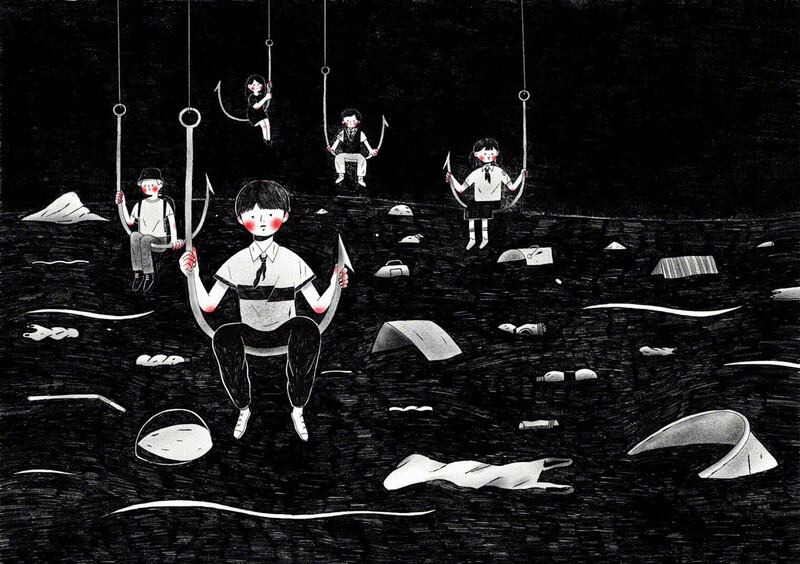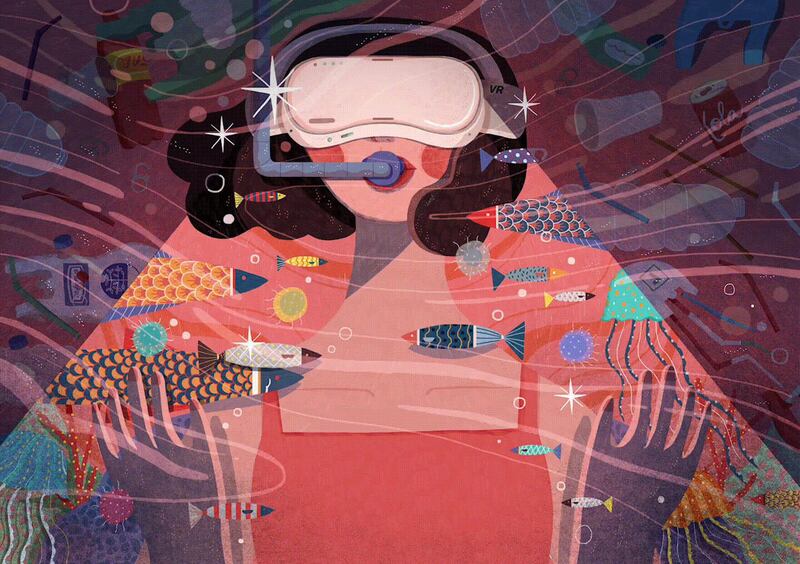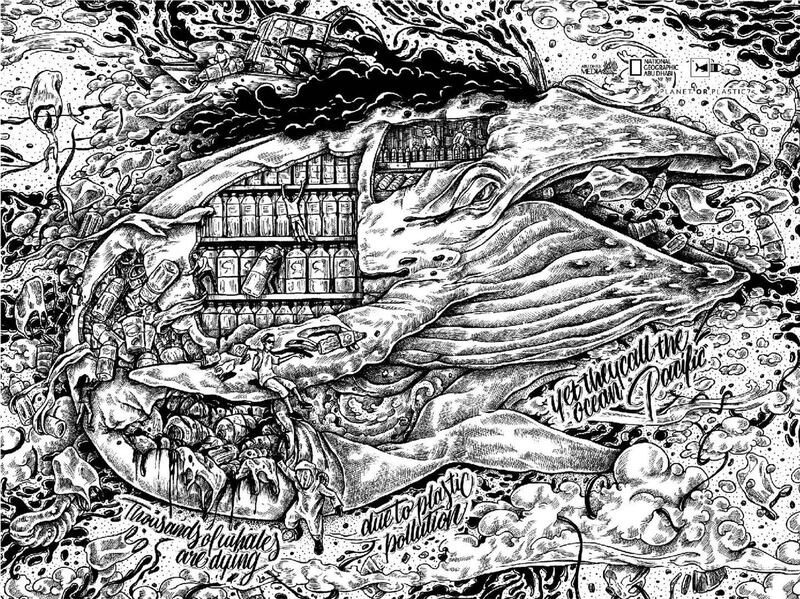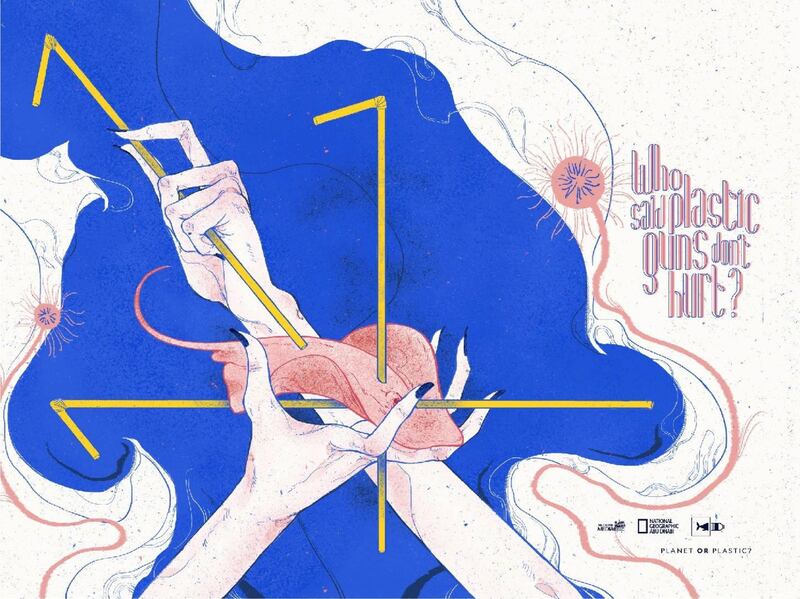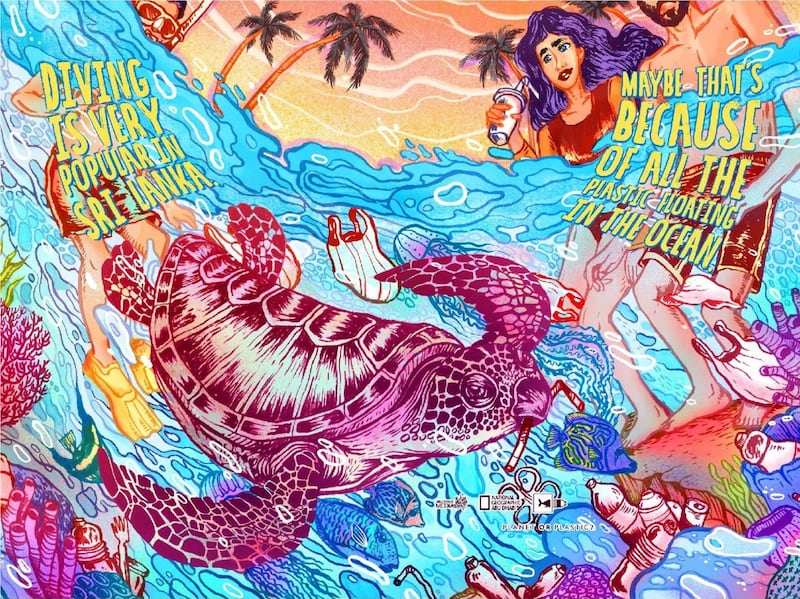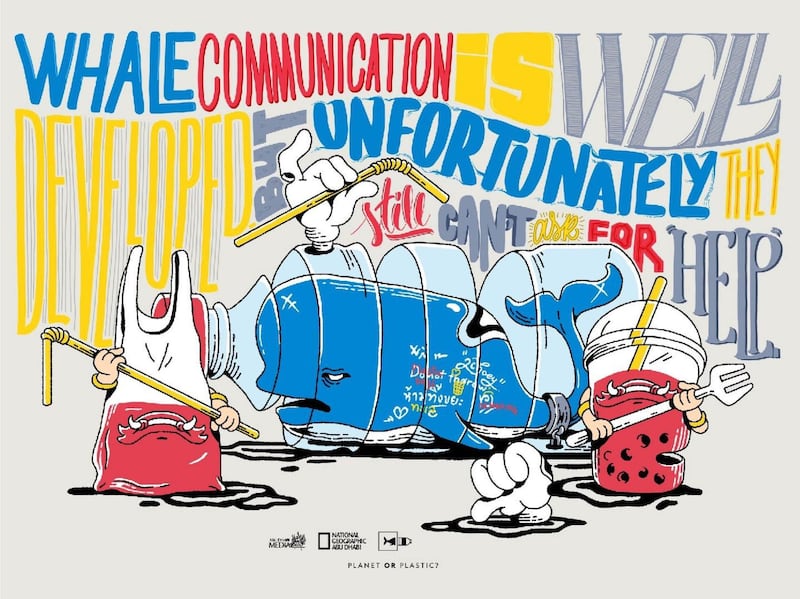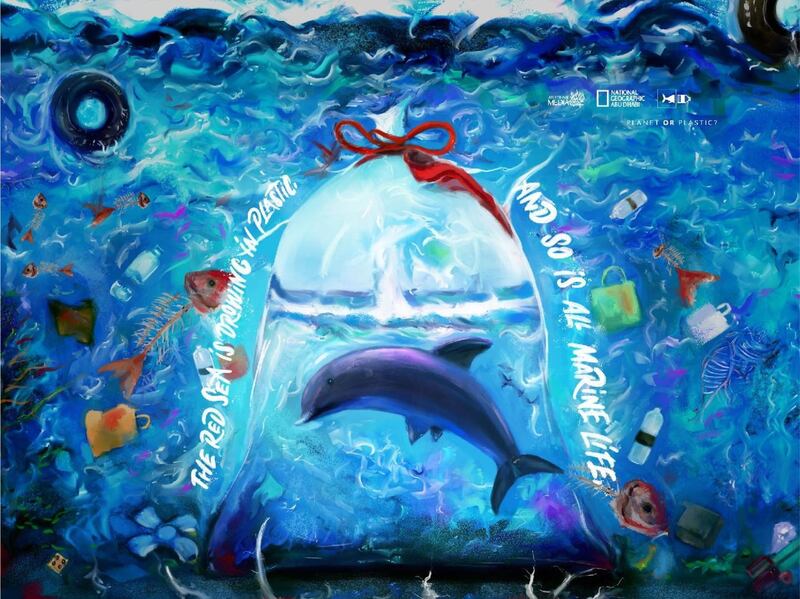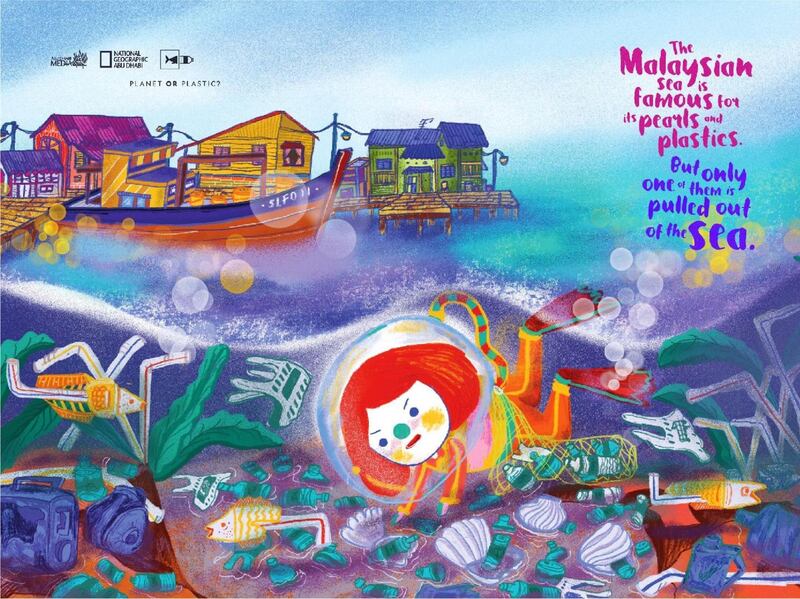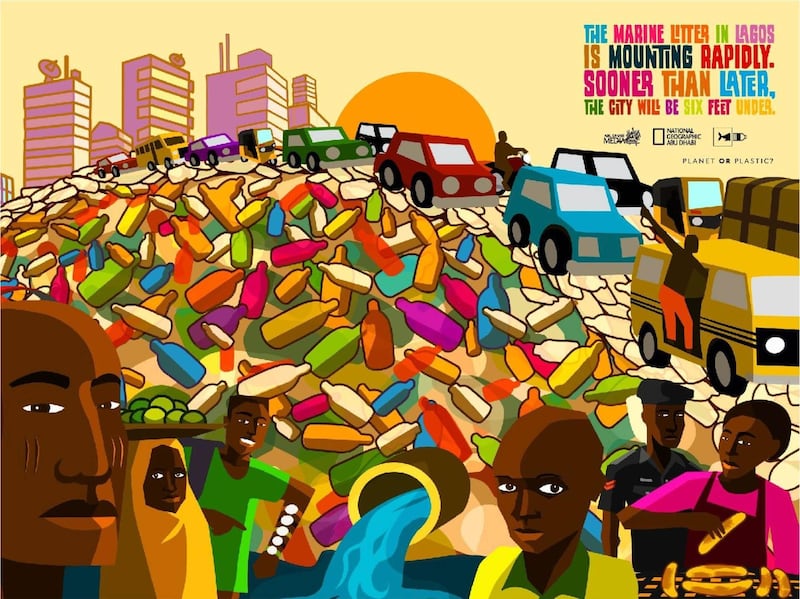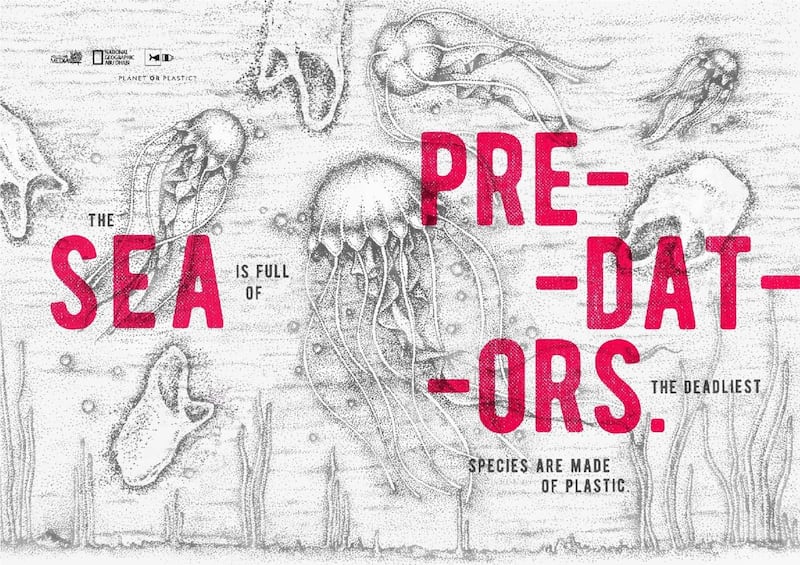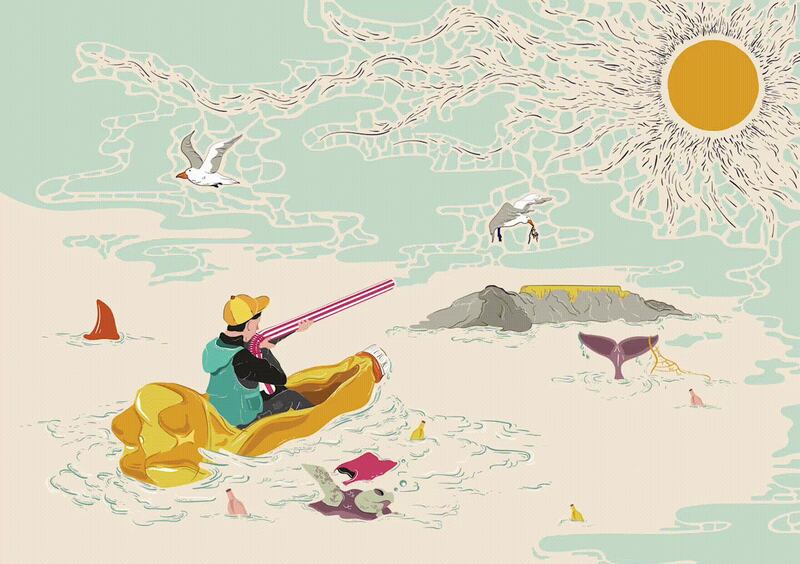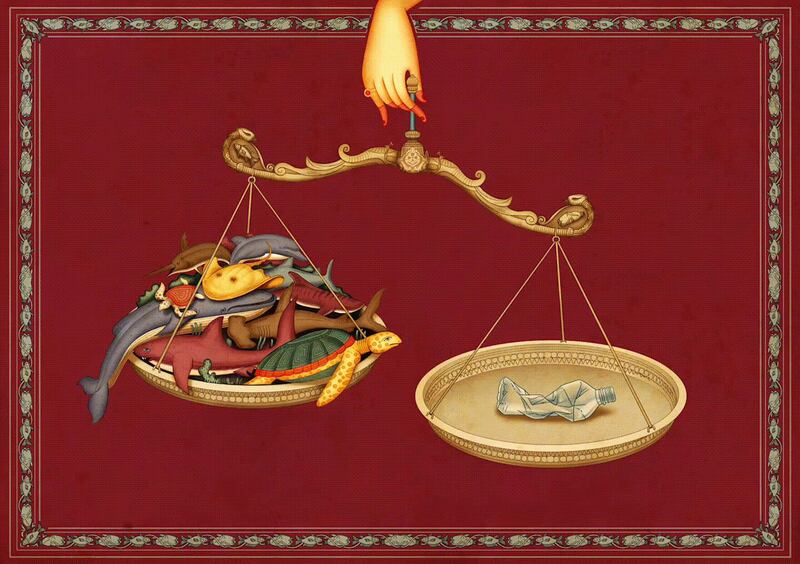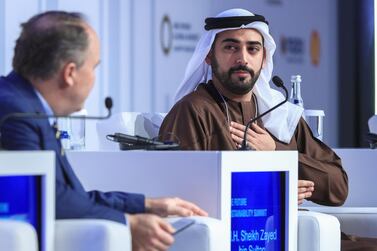There are 12 countries responsible for most of the plastic dumped in the ocean every year. As part of National Geographic Abu Dhabi’s Planet or Plastic campaign, an artist from each of those nations has contributed to a striking new calendar to raise awareness of ocean pollution.
January
Artist: Sheng Chen
Country: China
The illustrator from Shanghai conjures a gloomy picture for January. In shades of black, white and red, children dangle from fish hooks above a sea littered with plastic. Chen’s mixed-media works are a form of social commentary, and this piece highlights recent studies that show plastic fragments are present in nearly two-thirds of the fish commonly consumed in Chinese meals. Of course, this poses a health risk to China’s future generations, as well as our marine life. Chen’s message? Let’s get children off the hook sooner rather than later.
February
Artist: Kathrin Honesta
Country: Indonesia
While the Indonesian government has pledged to reduce marine waste by 70 per cent by 2025, millions of plastic bottles, bags and fishing nets presently float in the ocean alongside marine critters. Through her distinct work, the illustrator from Jakarta tells eye-opening stories, merging technology with art. This is a colourful depiction of a woman wearing a virtual reality headset, who sees a beautiful underwater scene full of exotic species swimming happily about. Outside her line of sight is the dark and ugly truth – a sea full of plastic.
March
Artist: Kristy Anne Ligones
Country: Philippines
The artist and illustrator who goes by the name KDLIG, lives in Dubai and loves lending her talents to the planet. Her style could be described as pop surrealism, and she’s highly influenced by lowbrow art, having previously worked as a graphic designer for an American publishing company in Cebu. Her elaborately drawn piece is a comment on the waves of single-use plastics that end up on supermarket shelves, only to later be consumed by the Philippines’ whales. The small city of San Fernando is now composting and recycling 78 per cent of its household garbage, but there’s still plenty to be done to tackle ocean waste in her home country.
April
Artist: Thao Mien Phan
Country: Vietnam
The graphic designer merges her enthusiasm for traditional art and marine biology in her intricate works through subtle colour combinations and poignant messages on sea life. This piece focuses on the stingray, which has been skewered by straws – a nod to the 500,000 tonnes of plastic dumped in the ocean every year in Vietnam. In order to tackle this, the country has been working closely with the international community on coastal clean-ups and educating consumers on the dangers of single-use plastics.
May
Artist: Ruwangi Amarasinghe
Country: Sri Lanka
Vibrant colours and intricate details underpin the works of this illustrator and mural artist from Colombo. Her colourful piece zooms in on one of the world’s most beautiful surfing and diving spots in her native Sri Lanka, yet the Indian Ocean is one of the most polluted oceans on the planet. “The only way to reduce pollution is by making changes to our own lifestyle,” she says.
June
Artist: Bom Cherdsak
Country: Thailand
The Australian resident and painter was inspired by the discovery of a dying pilot whale off the southern coast of Thailand, after it swallowed 80 plastic bags. “The message I want to send out is that plastics are more dangerous than we think,” Cherdsak, who goes by the pseudonym 2CHOEY, said. The incident inspired a nationwide campaign, Beat Plastic Pollution, in Thailand.
July
Artist: Ahmed Karam
Country: Egypt
The Red Sea was known as a pristine location set on a pedestal in terms of its abundance of marine life and coral reefs. As constant streams of waste pour in, a sea of single-use plastic is left. While the local government steps up, digital artist and painter Ahmed Karam has created a devastating blue-hued scene of a dolphin trapped in a bag, as if it’s a goldfish won at a funfair.
August
Artist: Kelseyz
Country: Malaysia
The Kuala Lumpur visual artist and illustrator’s home country is one of the most pearl-rich in the world, but the dumping of millions of tonnes of waste every year has seen plastic bags begin to outnumber the gems. The local government has since imposed a levy and ban on plastic waste imports, but Kelseyz, aka Troublexy, who has produced a cartoon-style drawing with a child-like character that features frequently in her body of work, won’t allow us to forget the damage that’s already been done.
September
Artist: Thomas Ero
Country: Nigeria
In artist and illustrator Thomas Ero’s native Nigeria, the Lagos Waterfront Clean-up Initiative has been set up to prevent the city from drowning in single-use plastic. A total of 450,000 tonnes ends up in the ocean annually from the African nation – enough to build another of the city’s Third Mainland Bridge. Ero’s colourful work reflects African culture amid changing environmental times, as plastic bottles pile up, a never- ending stream of planet-polluting cars drive by and residents complacently look on.
October
Artist: Helena Layzu
Country: Bangladesh
Jellyfish and turtles that live off the coast of Bangladesh often mistake the plentiful transparent plastic bags that float around in the ocean as food. As the country’s waste problem moves into dangerous territory, the government has passed a law to ban polythene bags and has committed to significantly reducing marine pollution by 2025. Helena Lazyu – a fine artist, graphic designer and illustrator from Khulna, Bangladesh’s third-largest city – illustrates her take on the matter through “pen drop art”, which portrays swimming jellyfish and floating plastic.
November
Artist: Wilmari Botha
Country: South Africa
Wilmari Botha’s artwork may look whimsical, because of her distinct printmaking-inspired style, but the message is dead serious. A child floats along on a giant plastic bottle, brandishing a “gun” fashioned out of a straw, aimed at a seagull that’s attempting to ingest dumped garbage. Around him swim struggling sea creatures and more waste. “The power is in our hands,” she says. “We can make better choices every single day to reduce the amount of plastic that enters our ocean.” South Africa, as a nation, is taking positive steps towards reducing plastic waste – the food and drinks industry has stepped up its recycling efforts, and stopped the import of polyester staple fibre.
December
Artist: Pavan Rajurkar
Country: India
The Mumbai artist’s message is clear. The illustrator depicts in his artwork how every single plastic bottle tips the scale in terms of the massive damage it does to our marine life. His home country, India, has a population of 1.3 billion people and generates more than 15,000 tonnes of waste daily. But it also has one of the world’s toughest anti-plastic laws, and has vowed to ban all single-use plastic by 2022. “The plastic waste we create has a life-span which exceeds the life of all the organisms on Earth,” Rajurkar says. “Our negligence has a heavy price. Any small behaviour changes [from] people who see my illustration will give me the satisfaction that I am contributing to saving planet Earth."
